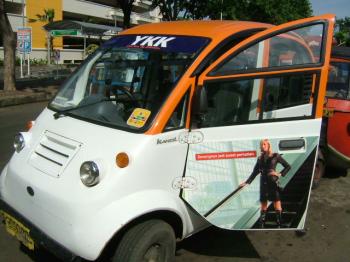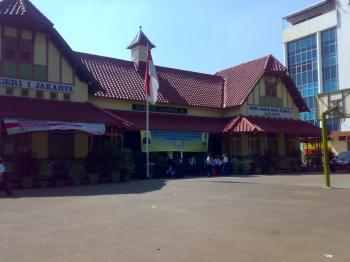Getting Around Jakarta
Getting Around Jakarta
All City Transport Options: What Locals Use and What’s Best for Tourists
General Overview
Getting around Jakarta can be an adventure! One thing that surprised me about Jakarta transport is the sheer variety of options available, even if it takes a bit of practice to navigate it all. The public transport system is improving, but some routes can feel chaotic.The main types of public transport include TransJakarta buses, commuter trains (KRL), and the MRT, which are all quite efficient once you get the hang of them. TransJakarta runs from early morning until around midnight, while the MRT usually operates until about 11 PM. KRL trains run from around 4 AM until after midnight, but do beware of rush hour; that’s when they can get packed like sardines. Ticket prices are super affordable—TransJakarta and MRT rides range from about IDR 3,500 to IDR 8,000, while a KRL ticket is around IDR 2,000 to IDR 10,000 depending on your destination. For comparison, a regular taxi ride can set you back anywhere from IDR 30,000 to IDR 150,000 or more, depending on distance and traffic (and that can be serious here!).
Oh, before I forget, many visitors think they can just hop into any taxi and get the best deal; it’s actually smarter to use the rideshare apps instead—much more reliable and cheaper, especially during peak hours. A local hack? Downloading the “JAKI” app provides real-time schedules for TransJakarta, which can save you a lot of waiting time.
I’ll tell you, my first time using the MRT was a bit of a frustrating puzzle when I realized I had to swipe the card multiple times (you only swipe out of the station, not in!). But then, I was pleasantly surprised at how clean and efficient the MRT is compared to some other cities I’ve visited.
On busy days, like Mondays after work, expect the KRL to be jam-packed; it's best to avoid riding after 5 PM unless you like being pressed against fellow commuters. And don’t be fooled by the weather; even if it looks clear, sudden rain can cause massive flooding, which makes transport a hassle.
Overall, your best bets would be the TransJakarta routes 1 and 9 if you're heading toward the city center or Bundaran HI station for landmarks. Just keep an eye on your belongings—pickpockets can be around on crowded transport.
A helpful takeaway? Consider getting a multipurpose transit card, especially if you plan to move around a lot! Jakarta’s transport might seem a bit chaotic at first, but it’s definitely manageable with a little patience and practice.
Types of Transport
popular with tourists
The bus system in Jakarta is mainly served by the TransJakarta bus rapid transit (BRT) network, which covers major areas and key attractions including Kelapa Gading, the National Monument, and Blok M. A one-way ticket typically costs around 3,500 IDR (approximately $0.25), and you can pay using a smart card called the JakCard, which can be purchased and recharged at various stations. For tourists, it's recommended to familiarize yourself with the bus routes via the TransJakarta app or website, as it offers real-time information and route maps. To save time, try to avoid peak hours (rush hours are generally from 7-9 AM and 4-6 PM) when buses can be crowded. Always keep your belongings close in any public transport setting for safety, and it's advisable to use the dedicated bus lanes to avoid heavy traffic.

popular with tourists
Taxis in Jakarta are a convenient way to navigate the city, with a wide coverage that includes major tourist areas such as Sudirman, Kuningan, and the Old Town (Kota Tua). Most taxis operate on a meter system, with base fares starting around IDR 7,000 plus IDR 4,000 for each kilometer, so expect typical rides within the city to cost between IDR 30,000 to IDR 150,000 depending on distance and traffic. Always confirm that the driver turns on the meter at the start of your journey to avoid any overcharging, and be cautious about using taxis that seem to be waiting in areas that are not designated taxi stands.
For a hassle-free experience, consider using ride-hailing apps like Grab or Gojek, which can provide upfront pricing and ensure safety through tracking. It’s also advisable to have your destination written down in Indonesian or saved on your phone to show the driver, as not all taxi drivers speak fluent English. Lastly, try to avoid peak hours (typically between 4 PM - 8 PM) to save time and ensure a smoother ride.
For a hassle-free experience, consider using ride-hailing apps like Grab or Gojek, which can provide upfront pricing and ensure safety through tracking. It’s also advisable to have your destination written down in Indonesian or saved on your phone to show the driver, as not all taxi drivers speak fluent English. Lastly, try to avoid peak hours (typically between 4 PM - 8 PM) to save time and ensure a smoother ride.

The auto in Jakarta is widely used, and you will find various car rental services and ride-hailing apps like Gojek and Grab readily available throughout the city. Typical costs for a ride can range from IDR 20,000 to IDR 150,000, depending on the distance and time of day, and payments can be made via cash or through the app using digital wallets. For tourists, it's advisable to download the ride-hailing apps upon arrival as they offer English language support and upfront pricing, ensuring transparency and convenience.
Keep in mind that traffic congestion in Jakarta can be severe, especially during rush hours (7-9 AM and 5-8 PM), so plan your travel accordingly and consider using their time-saving feature, which suggests faster routes. Additionally, always wear your seatbelt and ensure that your driver follows traffic rules for a safer experience while traveling through the bustling city.
Keep in mind that traffic congestion in Jakarta can be severe, especially during rush hours (7-9 AM and 5-8 PM), so plan your travel accordingly and consider using their time-saving feature, which suggests faster routes. Additionally, always wear your seatbelt and ensure that your driver follows traffic rules for a safer experience while traveling through the bustling city.

Walking in Jakarta can be a rewarding way to explore its vibrant neighborhoods, but it's essential to plan your routes wisely, as pedestrian infrastructure can be sporadic. Key areas like Menteng, Kemang, and Senopati have better sidewalks and are more pedestrian-friendly, making them great for leisurely walks. Always use cash, as many small local businesses and street vendors do not accept credit cards; you can expect to spend around IDR 10,000-50,000 for a small snack or drink as you explore.
For a more immersive experience, consider walking along Jalan Sabang, known for its street food and bustling atmosphere, while keeping an eye out for traffic, as road crossings can be perilous; try to seek pedestrian bridges or traffic lights when possible. Lastly, walking in the early morning or late afternoon can help you dodge the worst of Jakarta's hot and humid midday heat, ensuring a more pleasant experience.
For a more immersive experience, consider walking along Jalan Sabang, known for its street food and bustling atmosphere, while keeping an eye out for traffic, as road crossings can be perilous; try to seek pedestrian bridges or traffic lights when possible. Lastly, walking in the early morning or late afternoon can help you dodge the worst of Jakarta's hot and humid midday heat, ensuring a more pleasant experience.
Here you can learn about all types of transport in Jakarta. What transport is available, how to reach tourist attractions and which mode of transport is optimal.

